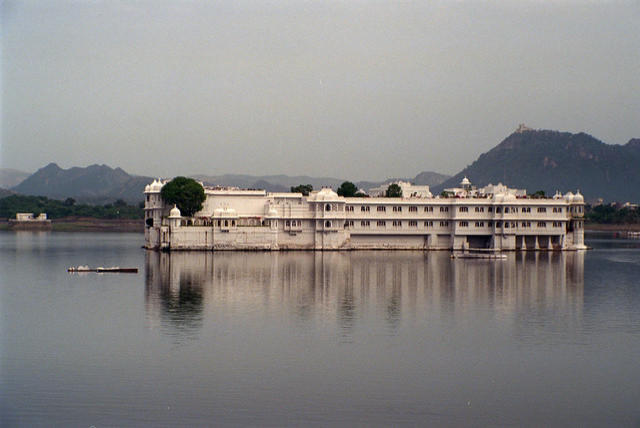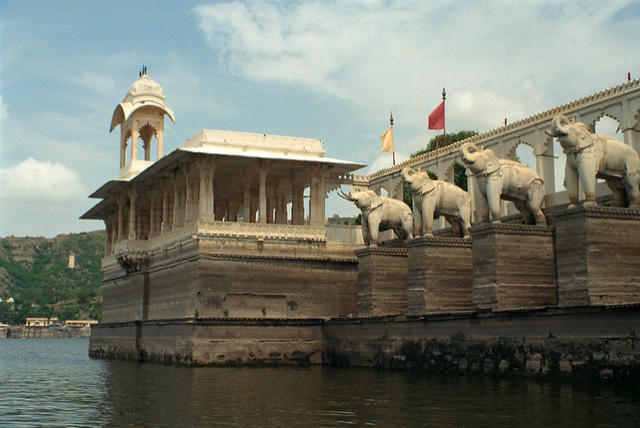

Rowan Castle - Travel & Photography

© Rowan Castle 2019
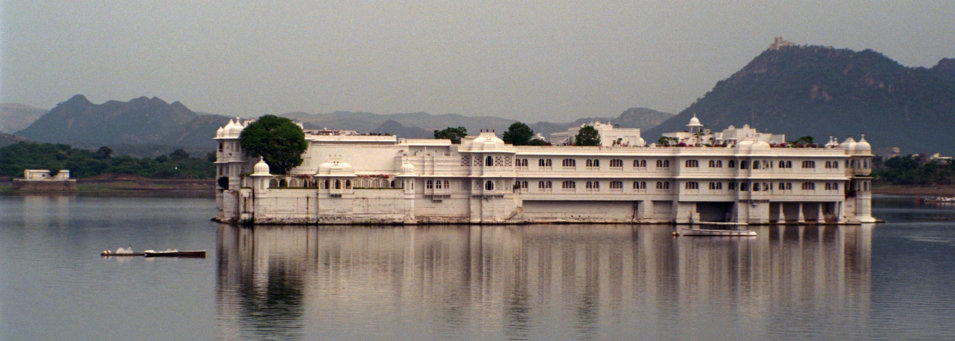

India and Pakistan 1996 - Diary


Day 1 - Thursday 4th July.
"Bombay hit me like no other city; at night the sandy beaches of Rio turn into
dormitories, the New York subway turns into a dormitory, but the whole of
Bombay turns into one massive dormitory - 21/2 million people are said to
find their home on the pavements of a city that is half as big again as London."
Nick Danziger, Danziger's Adventures.
As our aircraft circled above the lights of Bombay I couldn't avoid thinking about
some of the problems and culture shocks that might be waiting for me on the
ground. I knew that the drive into the city from the airport passed some of the
world's worst poverty, my guide book had warned that accommodation might be
very hard to find, and in addition I was arriving in the middle of the night with
traveller's cheques only (Indian rupees cannot be obtained outside India). To
leave Bombay I was to travel by train to Udaipur in Rajasthan, and yet every
time I had seen any of Bombay's railway stations on television, the crowds
scrambling onto the trains had been so frenetic that it seemed to me that a
westerner with a backpack would not stand a chance.
Fortunately, these problems were not quite as close at hand as they seemed, I
wasn't going to go into the city in the middle of the night and I had decided that
the next six hours or so would be spent sitting in the airport waiting for first
light.
I emerged from all the Immigration procedures and unexpectedly found myself
outside the terminal without seeing anywhere to change money. The dark sky
was heavily overcast, spots of rain were falling and the heat and humidity were
stifling. I knew that if I didn't find a waiting area fairly soon I was going to be
eaten alive by the swarms of mosquitoes. First though, I had to put all of the
things I had carried onto the plane as hand luggage into my backpack, it was a
struggle and I very nearly could not fit everything in. The pack was so heavy
that I could hardly lift it. There was no doubt that I had got off to a very bad
start.
Eventually, I managed to change some traveller's cheques and found a waiting
area with seats that were cooled by overhead fans. It was not long before I
struck up a conversation with a man sitting nearby. Shahpoor, a 42 year old
property broker from Madras, was about to fly to Iran. When he found out that I
was British, he said that India had gained a lot from the railways, legal system,
irrigation and common language that the British had left behind, but said that
since independence, Indian society had fragmented into regional groups -
Punjabis, Tamils and so on, and the systems of government had become more
and more corrupt. He said that a road project might be sanctioned costing 10
crore (one crore is ten million rupees), but it would be quoted by an official as
15 crore and the money siphoned off, all while there was terrible poverty. Some
people in Bombay, he said, were spending ten thousand rupees a night on
alcohol, luxury hotels and prostitutes while many people were forced to eat
from the gutter. It may have been dissatisfaction such as this that had lead to
the ousting of the old Congress Party government in the general election just a
few months before my arrival.
I spent the rest of the night waiting quietly, writing my diary and watching the
sky gradually lighten as dawn approached.
At six o'clock I jumped into a taxi and asked the driver to take me to the
Gateway of India, for the start of my journey. The drive into town exceeded my
grim expectations, very soon after leaving the airport we were driving past
huge slums, makeshift houses with only tarpaulin roofs to keep out the monsoon
rains and no sanitation. Further on, the shanty towns were obviously older and
their residents were starting to make their homes more permanent. The
tarpaulins had been replaced with corrugated iron, and makeshift walls
reconstructed with old brick. A few people were visible, placing small kettles
and pots over smokey fires, or picking their way over the piles of rubbish or
streams of sewage. Behind them were the entrances to dim alleys which
receded into the gloom. At one point we passed a wide area of waste ground,
rust coloured apartment blocks dominated the far horizon, while next to the
road a line of men were squatting to defecate.
The window of the taxi was wound down, and as the air moved over my face,
the mixture of air pollution and humidity coated my skin in a thin layer of sticky
and gritty residue.
Rather embarrassingly, the driver dropped me off at the door of a five star
hotel, I wondered why he had not dropped me at the Gateway of India as I had
requested, but since the famous Taj Mahal Intercontinental hotel is next to the
gateway, I assumed that that was where I was. I realised very quickly that I was
mistaken; the driver had dropped me off in the wrong place. From a small map,
I could see that I had been dropped on Marine Drive, overlooking the Arabian
Sea, whereas the Gateway of India was across the city, on the other side of the
peninsular, overlooking Bombay harbour. I was furious, but the driver had long
since gone and I had no choice but to walk.
It was still early morning, and the people who slept on Bombay's pavements
were waking up and I passed several who were trying to wash themselves while
lying in the gutter. Groups of people were standing around pots of tea or
cooking over small fires and without exception they all stared at me as I passed
by.
The walk should have been fairly short, I was navigating by using the digital
compass on my watch and I knew that I would reach the Gateway of India by
heading South East. However, my way was blocked by a long, thin park with
locked gates. I had to take a big detour and was becoming more and more
exhausted when I suddenly and unexpectedly came upon the sea and the
Gateway of India.
Weaving my way through the small crowd of touts and beggars, I descended the
big stone steps to the waters edge. Then I walked up through the Gateway
itself, to begin my journey in the same way as my Grandfather had begun his.
The Gateway of India, Mumbai.
The great arch was opened in 1924, and was built to commemorate the 1911
visit of King George V. Dominating the street behind the Gateway is the
impressive facade of the Taj Mahal Intercontinental Hotel, one of the most
luxurious hotels in India. Unfortunately, I wasn't going to be staying at the Taj,
but opted for Hotel Prosser's which was just along the road. As I made my way
there a man approached me with a small bag slung over his shoulder, he was a
snake charmer and the bag contained a cobra. I promised him I would come
back and watch his street show after I had found my hotel.
Hotel Prosser's was easy to find and I had no problem getting a room despite the
warnings in my travel guide. The room was extremely bare but clean, it might
have been a depressing place to stay and a bad omen for the hotels ahead, but
someone had written, "Don't let this place get you down, things and prices are
better elsewhere - try down south. For the prices here you could get a TV, hot
water and double bed and bathroom - luxury", on the wall.
Free from my heavy pack, I went back out and tracked down the cobra man.
Before his performance, he led me away from the crowds to a pavement and
produced the cobra's basket from his bag. He told me that he caught the cobra
in the jungle, and had ten more at home. I backed off when he took the lid off
the basket, but seeing my alarm he casually explained that he had pulled the
cobra's fangs out after he had caught it and so it was harmless. He tapped the
jet black snake on the head and it reared up in the famous striking stance, with
it's hood displayed to ward off attackers.
I took a taxi to Victoria Terminus, to reserve a seat on the train to Udaipur for
7th July. The terminus is a large and imposing colonial era building and houses
the main reservations office for Bombay, which is fully computerised.
Unfortunately, even with the help of modern technology, it was still quite
confusing. Luckily I had my ticket booked for me, for a commission, by a tourist
guide. Shah spoke perfect English and booked a ticket that covered my journey
all the way to Udaipur, which meant I would arrive a day early. He said that he
would even personally make sure that I went to the right station by meeting me
at noon on the seventh, and getting a taxi to take me to Bombay Central
Station. It was a great help to have had the ticket booked so easily, I had been
worried that leaving Bombay might have taken longer than I planned, but now I
would be a day ahead of schedule!
Victoria Terminus, Mumbai.
Back on the street I discovered that all the taxis were now on strike and so I
found my way back to the hotel on foot.
A while later I tried to walk to St. John's Church which is dedicated to the
soldiers who fell in the disastrous First Afghan War. For a while I was followed
by a little girl, who had no parents and was begging for powdered milk for her
baby sister. I hadn't gone much further when the road I was following
terminated at an enormous shanty town and I had to turn back. Walking
anywhere in Bombay was hard work, nobody walked on the pavement since this
was inevitably either broken, cluttered with street traders, or covered in
rotting vegetables and excrement. Bright splashes of orange slime were
everywhere on the roads and pavements, the waste product from people
chewing pan leaves, which is a national obsession in India. The pan leaves
surround the mildly intoxicating (and addictive) betel nut, the whole
preparation is chewed and the remainder spat out onto the street. This was
especially noticeable in Victoria Terminus where the walls were covered in the
orange scum.
In the evening I went to the Kamat restaurant on Shahid Bagat Singh Road,
which served vegetarian dishes only. I had a fairly tasty vegetable thali, rice,
chapati, nan bread and Pepsi for Rs 36 (about seventy pence).

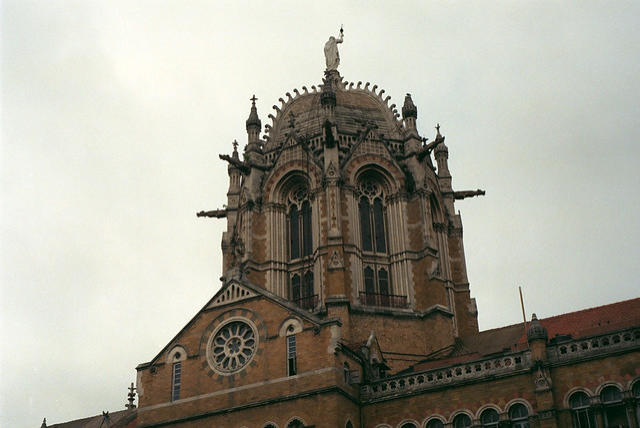
Day 2 - Friday 5th July.
Shortly before 9 a.m. I was at the Gateway of India, hoping to get on a boat
launch to Elephanta Island, Bombay's principle place of interest. The island
boasts several rock cut Hindu temples which are reached by a flight of stone
steps up through the jungle. Unfortunately, because the monsoon period (early
July to the end of September) is the tourist off season there were not enough
passengers and I was advised to come back at one o' clock.
I went north to the area around Victoria Terminus, found an international
telephone booth and phoned home. After that I decided to walk to the
Tareporewala Aquarium on Marine Drive (the taxis were still on strike). On the
way I saw several very large dead rats lying by the pavement. I walked along
Veer Nariman Road and emerged onto Marine Drive which sweeps round the
shoreline in a large arc from the opulent skyscrapers of Nariman point to the
south, to Chowpatty Beach and Malabar Hill to the north. Midway along the
Drive stood a small building which housed the aquarium.
The aquarium seemed to be very popular with local families and had quite a
wide variety of marine life on display. Among the most interesting animals were
lion fish, Indo-malayan catfish, moray eels, sea horses, Indian Tarpon (a large
sport fish with big eyes) and a tank of writhing sea snakes.
By the time I had walked back to the Gateway of India it was almost one o' clock
and this time I was able to get a ticket for a trip to Elephanta Island, aboard
one of the rickety wooden boats moored at the quay. The boat was mainly full
of Indian tourists but as we waited a few more Europeans boarded.
When we eventually cast off, we very slowly left the Gateway behind as the
launch chugged out across the bay towards a line of oil and chemical tankers
which stood at anchor in the haze. After an hour of gently cutting through the
murky waves, we arrived at the heavily forested island and pulled up alongside
a long concrete jetty, which led to the flight of steps up through the jungle.
The path to the caves was lined with stalls selling trinkets for the tourists, and
the occasional restaurant, while the undergrowth on either side was often
noisily rustled by monkeys. The climb up through the trees ended at a wide
glade on a ledge of the mountain, the main cave was cut straight into the rock
face, supported by mammoth pillars that had also been hewn from the stone.
The other smaller caves were unfinished and not particularly interesting.
The carvings at Elephanta are believed to date from 450 - 750 AD and the island
takes its name from the large stone elephant that was found at the Portuguese
landing place. Before the Portuguese changed the name of the island to
Elephanta, it was called Gharapuri, which means Fortress City. Unfortunately,
the carvings were damaged when the Portuguese soldiers used them for rifle
target practice, and the stone elephant fell to pieces in 1814 and the remains
were moved to Bombay's Victoria Gardens. However, despite the damage to the
site, the carved panels and statues in the main cave are very impressive. The
most significant images depict Siva, the Hindu God of destruction, as a
meditating Yogin (ascetic), as half male and half female and most importantly in
the Trimurti form, a three headed manifestation of Siva also incorporating the
deities Brahma (creation) and Vishnu (protection). One of the most eye catching
panels is of Siva as Nataraj (Lord of the dance) in which he dances the Tandava
(the dance that shakes the world), while another panel portrays the marriage of
Siva and Parvati.
The main cave at Elephanta Island.
Emerging from the cave, a small boy showed me a path which led up through
the jungle to the two cannons placed on the hilltop by the British in 1905. As we
walked up through the forest we saw many colourful butterflies and great views
out over the canopy of trees below. The boy pointed out his village, Raj Bander,
which lay in the valley beneath us. The track became quite steep and because
of the heat and humidity, I had great difficulty keeping up with my guide. When
we arrived at the hilltop and the first of the cannons we were rewarded with a
fine panorama of Bombay's skyline and the intervening sea.
One of the old British Cannons on Elephanta Island.
As I descended the steps back to the waterline I was startled not by a monkey
leaping from the trees but by a familiar English accent booming from a nearby
radio. I instantly recognised the voice of one of the BBC's cricket commentators
on the world service and remembered that England were currently playing India
back in the UK. The radio belonged to one of the souvenir stall owners and I
asked him what the current score was.
When I reached the jetty, I did not have to wait long for another launch back to
the city.
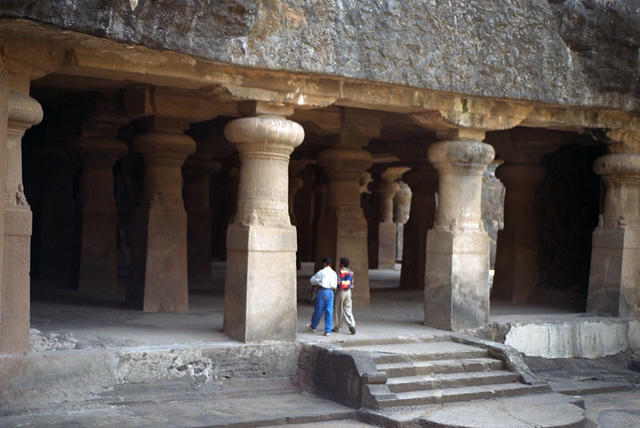
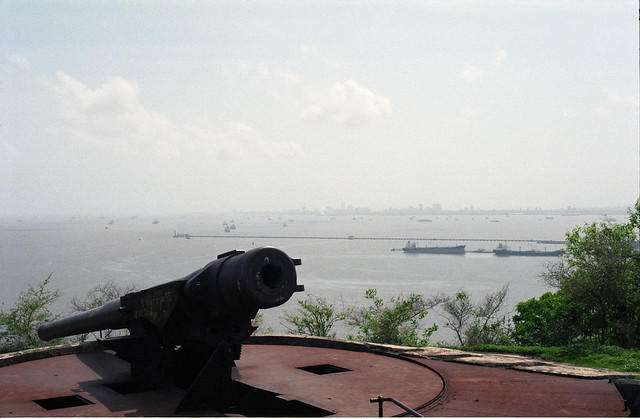
Day 3 - Saturday 6th July.
It was my last full day in Bombay and the taxis were still on strike which meant
that if I wanted to see anything of the city I would have to walk. I set off early
and went first to the American Express building at Wellingdon Circle, just up the
road from the hotel, to change enough money for the next leg of my journey.
The way through the city to Marine Drive and the shore was now quite familiar
to me, and soon I had arrived at the waste ground next to the aquarium, where
a group of boys were playing cricket. Following the shoreline, I came to
Chowpatty beach which was absolutely filthy. However, nobody bathes here
anyway, the beach is only popular at night when all sorts of stalls and
entertainment are on offer, and the whole place comes alive. Unfortunately
though, I never had time to visit during the evenings that I stayed in Bombay.
Leaving the beach behind, I was looking for a way up to the Hanging Gardens,
which are built on top of Bombay's public water reservoirs. Eventually after
some uncertainty as to which way to go, I found a small path leading up through
a thick wood. The emerald green vegetation and the exotic butterflies floating
past reminded me that Bombay lies south of the Tropic of Cancer, and that this
would be the only part of the journey that was in the tropics.
Chowpatty Beach, Mumbai.
Halfway up the hill I came to a couple of makeshift tarpaulin houses and a dog
rushed out to bark at me but luckily did not attack. A bit further on, the path
emerged onto a tarmac road opposite the entrance to the Hanging Gardens.
The gardens were a relaxing haven from the bustle of the city below, but were
not particularly impressive. Somewhere nearby, but well hidden from view,
were the Parsi Towers of Silence. The Parsis are the followers of a small
religion, and their numbers today are restricted mainly to Bombay and Karachi
in Pakistan. Their beliefs demand that they dispose of their dead by placing
them on stone pedestals (called Towers of Silence) where the bones can be
picked clean by crows and vultures.
The butterflies in the garden were very interesting , the most spectacular type
had bright blue wings with brilliant white stripes, but moved far too fast to be
studied closely. While I was wandering round looking at the butterflies I came
across a large group of Scouts who spoke very good English. They told me that
the ongoing taxi strike in Bombay was due to a very large rise in petrol prices
that was announced a few days before my arrival.
Returning to the road, I made my way down the hill, back to the shoreline and
continued walking north. This brought me to the road leading past the Breach
Candy Hospital and Research Centre, one of the finest in India. Nearby was a
viewpoint which provided me with one of the images of Bombay which remains
strongest in my memory, in the foreground was a huge heap of rubbish with two
makeshift houses built on top of it. The occupants were scavenging, barefoot
amongst the refuse while behind them the dirty grey sea crashed on black
mudflats. Moving on, I arrived at what I thought was my next objective, the
Mahalaxmi Temple, Laxmi being the Hindu Goddess of wealth.
The building I had come to was built of marble, and fairly small. In cases in
small alcoves in the walls were two statues, one of a cobra and the other was of
Kali, the fearsome manifestation of Siva's wife Parvati. The main statue was of
a deity which my limited knowledge of Hinduism did not allow me to recognise.
One thing that took a while to get used to is the fact that in Hinduism the
swastika is a sacred symbol and consequently is seen very frequently in India,
and there were a few painted on the walls of the temple. This was the first
Hindu temple I had ever been to and I was not sure of the proper etiquette and
where exactly I would and would not be allowed to go. For this reason, I
hesitated at the entrance and it was then that a middle aged gentleman
explained that the actual Mahalaxmi temple was further on up a small road, by
the shore.
The small lane which lead to the temple gates was crowded and lined with
shops selling garlands of flowers and coconuts, these were bought by the
worshippers heading for the temple and presented to the goddess as offerings.
The temple building itself was not particularly elaborate although it was quite
large. Those giving flowers and coconuts formed two queues, one for men and
one for women and gave their offerings to two men seated at the feet of the
statues of the Goddess and her two sisters.
Mahalaxmi Temple, Mumbai, India.
After more walking and more confusion over exactly where I was, I came to the
final place that I wanted to see before leaving Bombay. The Tomb of Haji Ali is a
beautiful marble building just off shore, at the point where Haji Ali, a Muslim
saint, drowned. It is reached only at low tide by a narrow causeway which is
lined with beggars and lepers, who benefit from the stream of pilgrims going to
and fro. The tomb itself is an imposing sight, the dazzling white marble,
decorated with gold inscriptions, is in sharp contrast to the grimy waters of the
Arabian Sea all around. The chamber which contained the shrine was richly
decorated with an incredible dome, made of a mosaic of small pieces of
mirrored glass.
My walk had left me slightly sunburnt and so I decided to stay in the shade of
the tomb until the hottest part of the day had passed. Fortunately though,
storm clouds gathered overhead soon afterwards and I was able to continue in
comfort. While I had been waiting, however, the tide had risen slightly and now
waves were crashing against the sides of the causeway showering those crossing
with the fetid and polluted water. The slicks of sewage and waste could be seen
floating on the sea on either side of the causeway.
At the tomb of Haji Ali, Mumbai.
Retracing my steps I travelled back through the Hanging gardens and along
Marine Drive. I stopped at a smart pizza restaurant for a meal and I noticed that
it shared the building with a night-club called 'Jazz By The Bay' which I thought
was bound to be one of the most fashionable places in Bombay, especially given
its exclusive location on Marine Drive.
After resting in the hotel (I had walked all day), I emerged at 9.30 and headed
for Leopold's Bar and Restaurant. As I left the hotel, I heard a rustling in the
gutter and looked down just in time to see a massive rat scuttle away into the
darkness.
At the restaurant I had my first taste of Lassi (a yoghurt / milk drink) but it was
not as tasty as I had expected. I also had a very nice glass of beer with my
Chicken Biryani, but I did not drink too much because excess alcohol leads to
dehydration very quickly in a tropical climate.
The pavement dwellers were settling down for the night as I made my way back
to the hotel, and it was not long before I saw another big rat.
During the evening I had heard good news about my journey to the railway
station tomorrow, the taxi strike was over and transport would no longer be
such a problem. However, the end of the strike came too late to allow me to
see as much of Bombay as I would have liked. Overall, I was glad to be leaving
the city though. Everything in Bombay is on such a huge scale; the distances,
the crowds and of course the poverty, that it makes the city a very difficult
place to start a long journey.
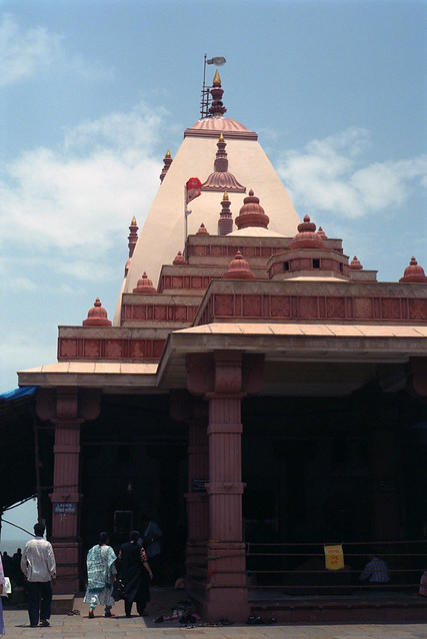
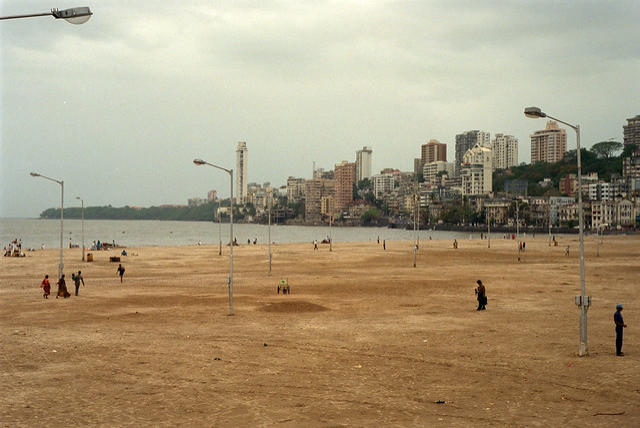
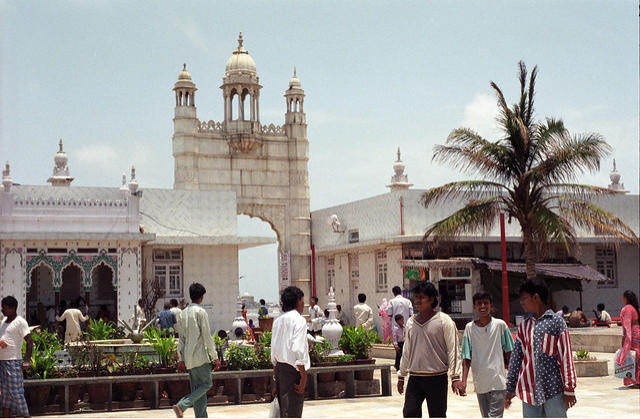
Day 4 - Sunday 7th July.
I was looking forward to leaving for Udaipur so much that it seemed a long
time to wait before I got a Taxi to Victoria Terminus at 11.15 in the morning.
Shah was there to meet me as arranged, he quickly reconfirmed my ticket
before instructing a taxi driver to take me to Bombay Central.
Bombay Central was a lot smaller than Victoria Terminus and much less
confusing, I soon found the platform from which my train to Ahmedabad
would leave. I had about an hour to wait, and as I sat in the station I found
myself being pestered by a small boy. I didn't pay much attention to him until
I suddenly heard a very loud crack. I turned round to see that a policeman had
just hit him over the wrist with a lathi ( a long Indian cane). Amazingly, the
boy stood his ground and the policeman hit him unbelievably hard over the
other arm. I still don't know how this punishment did not break both of the
boy's wrists. I didn't see exactly what happened but I suppose my
concentration must have lapsed and the boy must have tried to pick my
pocket and then been spotted by the policeman.
The next person who approached me was a fellow European, a Belgian
teacher called Raphael, who spoke excellent English. We soon discovered that
we would be on the same train and spent the rest of the time at the station
comparing notes on Bombay. As I had entered the city I had realised that the
culture shock, although considerable, must have been less for me, having
been to the Indian Subcontinent before than for someone who had not.
Raphael had definitely found this to be the case. Although he had travelled
widely in the Middle East (largely due to his interest in the story of Lawrence
of Arabia) and had stayed in Harlem in New York, he admitted that he had
found Bombay overwhelming. He had pre-booked his accommodation for the
first night at a very expensive hotel and once he had seen what the city was
like, he didn't come out of the hotel until it was time to leave. I later learned
that, like me, Raphael had been inspired to visit India by his Grandparents,
who had toured the country after retirement and had loved every minute of
it.
It was soon time to board our train, and we found out from our tickets that
we were booked into the same first class carriage. With no one to guide us,
and with no indication on the carriages themselves as to which one we should
be on, we dived into the first carriage that we found. We settled into our
seats, both anxious to be on the move, and found ourselves continuously
under siege from the child beggars that lived on the platform. I had once seen
a documentary about the terrible plight of these homeless children who lived
in the station, surviving on the generosity of the passengers. They have no
parents, nowhere to go and there is no welfare organisation for them to fall
back on. The kids who boarded our carriage looking for rupees and cigarettes
were dressed in rags and their teeth were filthy and decaying.
We had actually boarded a second class carriage by mistake. However, we
were soon guided to our seats by a man who's catchphrase seemed to be
"Wishing you good health, long life, prosperity and ......EVERYTHING!" and he
had said this a few times before showing us where to sit and collecting the
backsheesh we were obliged to give him for helping us out.
The train left Bombay on time, and made its way out through the miles of
slums and between the blocks of flats that form the outskirts of the city.
Before leaving the suburbs, we stopped at Bovarili station where Vaibahv, a
student who had booked the seat next to Raphael, got on. Vaibahv was
studying for a master’s degree in Ahmedabad and was on his way there from
his home in northern Bombay. He spoke very good English, had a wicked sense
of humour and he told us a lot of interesting things about India and what we
could expect when we reached Udaipur.
The outer reaches of Bombay eventually gave way to a low lying swampy
terrain dotted with lakes, a few makeshift houses and scattered palm trees.
On our right, to the east, were a line of small mountains, which I assumed
were the foothills of the Western Ghats. We would actually have had a better
view during our journey had we been in second class, where there are only
iron bars across the open windows as opposed to the armoured glass of the
first class carriages.
We were soon passing through Surat, the coastal city which had hit the
headlines two years ago when it suffered an outbreak of the plague in which
fifty people died. Essentially Surat had the same problems as Bombay, it had
become affluent (through diamond mining) and this had attracted people into
the city from the villages, once in Surat, they had no choice but to build huge
shanty towns where they lived in terrible squalor. The city was also the site of
the first landing in India by the East India Company, when Captain William
Hawkins anchored his ship, Hector, off the coast there in 1608. More company
voyages followed and this set in motion the chain of events which eventually
lead to British rule over virtually all of India, which persisted until 1947.
Just after leaving Surat we crossed the River Tapti and then the River
Narmada before stopping at Bharuch and Vadodara. Long after nightfall, we
arrived in Ahmedabad, where Raphael and I had to change trains for Udaipur.
We were fortunate in that Vaibahv had said that he would show us which
platform our train would leave from, and this was a great help in the
confusion of the big crowds at the station, where we said goodbye to him.
The platform where we had to wait was home to some big, fast cockroaches
as well as rats and harmless geckos. It was supposed to be a half hour wait
but in the end the train was delayed and did not leave until about two in the
morning. Meanwhile, we were joined by two more Europeans, Matt and Kate,
who were also travelling to Udaipur, they had also been on our train up from
Bombay. Not long after this we met Dominic, an American from New Jersey
who had been part of the team building the new American Embassy in Kuwait,
now that the work was finished he was travelling round the world before
returning to America.
While we waited, we exchanged stories about our journeys in India and this
made the time pass very rapidly. We were all amazed to see a steam train
trundle slowly past, because there had been quite a lot of publicity about the
end of India's steam locomotives and yet here one was, long after they had
supposedly been phased out. When our own train finally arrived, the scene
was one of total confusion because of the difficulty of identifying which
carriage was which. As a result we all decided to clamber into the same
carriage and hope for the best. It was pitch black inside and Matt quickly
produced a torch from his backpack, which enabled us to find the switches for
the light and the overhead fans. We found that we were in a second class
compartment with hard wooden seats and no beds. I had actually booked a
seat in a first class sleeper, but had no idea where it was and preferred to
stay in second class. We settled in and passed round biscuits and mineral
water. Just as we began to feel that we were at least comfortable and would
not have to move, two ticket inspectors came round and directed Raphael,
Matt and Kate to a different section of the train but left me where I was. The
bench may have been uncomfortable but at least I had plenty of room for my
backpack and could look out of the open window, with only two horizontal
iron bars between me and the Indian countryside.
At last our train pulled away into the night, and I started the most enjoyable
(but uncomfortable) railway journey I have ever experienced.
Day 5 - Monday 8th July.
Our progress was slow at first, stopping frequently and seemingly for a good ten
minutes each time. There were other people in the carriage but only one other
person in the partitioned part of it that I occupied.
After the hesitant beginning, we were soon rattling through the part of the
state of Gujarat that lay between Ahmedabad and the border with Rajasthan.
The track ran behind several large factories before shadowing a road for a large
part of the way. Every so often an off-shoot road would cross the track via a
level crossing and I could catch a fleeting glimpse of the crossing attendant
sitting in his little kiosk. By now, regular flashes of lightning were illuminating
the countryside and adding to the atmosphere of the journey.
In the small hours of the morning the nature of the scenery gradually changed.
The soil became more sandy and rocky; we passed over several dried up water
courses which made me think that the monsoon rains must have been slow to
arrive in this area. With the dawn, stony hills with scattered trees had risen up
around us.
The daylight brought the start of the best part of the journey, and an incredible
discovery. In the scramble to board the train in the darkness at Ahmedabad I
had not noticed that we were being pulled by a steam locomotive! Now I could
see the plume of thick black smoke and bright sparks from the engine up ahead
and the inside of my carriage was peppered with large particles of coal dust.
With the doors at either end of the carriage opening inwards and left wide
open, it was possible to stand at the entrance and look out over the
countryside. It gave the illusion of flying a few feet above the fields and
occasionally the ground would fall away altogether, as the track crossed a deep
river gorge on a viaduct, and then I would be looking straight down a one
hundred foot drop.
Crossing one river, I saw a momentary but brilliant flash of blue as a Kingfisher
skimmed across the water. The Kingfisher is also native to Britain and Europe,
but most of the birds in India are not and I knew that I would see many
interesting and unusual birds during my journey. For this reason I had bought
the excellent book Collins Birds Of India, Nepal, Pakistan, Bangladesh & Sri
Lanka, and had it with me in my backpack. The book was to prove extremely
useful during the trip and I noticed that it was amazing how much more at
home I felt in India and Pakistan when I could identify at least some of the
every day wildlife. Bird spotting was also something to do during very long bus
and train journeys.
In the early morning we pulled into the small station at Dungarpur and the man
sitting opposite me bought me a cup of tea from a stall on the platform. We
stopped for about fifteen minutes and I got out to stretch my legs. The rest at
Dungarpur was the part of the journey which I remember best; the sun had not
yet risen fully and so the temperature was perfect, there were small trees on
the platform with beautiful pink blossom and the tea tasted marvelous. To cap
it all, our locomotive vented a spectacular plume of steam which shot sideways
across the platform. Dominic managed to capture the moment on his camcorder
and I had a chat with him before re-boarding the train. We were lucky to be
travelling in the style of a bygone era, seeing India from a steam train just as
the British did in the days of the Raj.
As we rolled on through Rajasthan, the countryside became increasingly
dramatic and the track wound its way through deep cuttings blasted into the
rock, along high hillsides and through many tunnels. By this point I was very
tired and found myself dropping off to sleep more and more often, only to wake
up to brush specks of coal dust from my eyes and hair. It was not until the early
afternoon that we finally arrived at Udaipur City Railway Station.
On arrival, I was reunited with Raphael and the group I had met at Ahmedabad
and we made an effort to find one hotel in the Lonely Planet guide that we
could all stay at. In the end, Matt and Kate, Raphael and I decided to try the
Mahendra Prakash Hotel while Dominic opted to try out lots of hotels by hiring a
horse and cart. Those of us going to the Mahendra Prakash Hotel clambered into
several auto-rickshaws (three wheeled scooters with a passenger compartment
welded onto the back) and roared off towards the old city. Raphael and I had
not travelled very far before our rickshaw was in collision with a small motor
scooter. The two drivers shouted at each other for a few seconds and then we
drove off.
The Mahendra Prakash Hotel was very smart and clean and the staff were
extremely friendly. The room that I got was palatial, with a double bed, air
conditioning, a ceiling fan and a spotless bathroom (with western style toilet as
opposed to the squat variety). All this was only Rs 50 (£1) more expensive than
the bare room with no bathroom that I had stayed in in Bombay. Over the next
few days, the hotel became like a second home to me and contributed to
making my stay in Udaipur one of the highlights of the whole trip.
Udaipur, with its Maharaja's palaces (including the famous lake palace) is
renowned for its splendour, and I did not want to waste any time staying in the
hotel when I could have been out exploring. For this reason, I set off into town
almost straight away even though it was raining. The shower soon became a full
monsoon downpour and before I had got very far the street had become an
ankle deep river of filthy water. I took shelter by standing on the porch of a
shop in the bazaar, and must have been there for half an hour with little sign of
the water level beginning to fall. I saw that it was possible to hire bicycles from
a shop across the road and after the flood waters were no longer carrying down
lumps of floating rubbish, I waded across the torrent. The rate for hiring the
cycles was very cheap and I borrowed one for an hour and took to the roads in
and around the old city.
First I went back past the hotel, heading in the direction of Udaipur's famous
lake and palaces, which were very close at hand. The old city stands on the
eastern shore of Lake Pichola and was founded in 1568 by Maharana Udai Singh
II, supposedly on the advice of an old sage who was living by the waters edge.
The Maharana had to build Udaipur after his former Capital, Chittorgarh, was
sacked by Akbar, one of the great Moghul emperors. The brilliance of the
palaces and temples attracts many tourists from all over the world, and the
value of the city as an exotic background location was not lost on the makers of
the Bond movies, who filmed Octapussy there. The shoreline at the old city is
dominated by the massive City Palace, the largest in the whole of Rajasthan,
which is now a luxury hotel. From the road that runs in front of the City Palace,
there is a fine view of the Lake Palace which stands a short distance away out in
the lake itself, and is also a luxury hotel.
Turning round and retracing my route, I cycled to the main bazaar area and
found that cycling through Indian streets was a real challenge. For one thing,
cows are sacred in India which means that many of them roam the streets and
have to be dodged by cars and cycles alike. Then there was the threat of being
run over by an auto-rickshaw or motor scooter, and of course, I had to weave
my way round the hordes of pedestrians who were obeying the golden rule I had
observed in Bombay: never walk on the pavement. The bazaar itself was busy
and colourful, but my cycle ride was only meant to allow me to familiarise
myself with the layout of the city and I did not explore in detail. I knew that
there would be plenty of time to investigate the bazaars and the palaces in
much greater depth in the days ahead. I returned the bicycle, and trudged back
through the muddy streets to the hotel.
Arriving in a new town had given me a burst of energy, but now I was
desperately tired and longed to sleep. However, Raphael managed to persuade
me to take a walk round the city with him. We were just about to set out when
one of the Hotel staff suggested that we would be much better off taking a trip
up a nearby mountain to see the Maharaja's Monsoon Palace, where there would
be good views over the city and lake. He arranged an auto-rickshaw for us and
we drove out of the city centre, towards the outskirts. Just before we left the
city for the countryside, we passed a wide rubbish dump which was being
picked over by Cattle Egrets, and the white bird's heads were bedecked in their
orange breeding plumage.
The road began to wind steeply up a rocky mountain covered in scattered trees
and we were really beginning to enjoy the trip when we suddenly ran out of
petrol. We had no choice but to walk the rest of the way up to the summit, and
the rickshaw driver set a furious pace, I still don't know how I managed to keep
up with him. At the top of the hill stood the derelict palace of the Maharaja of
Udaipur and to gain admission we walked up to the massive wooden gates and
knocked. Our visit to the palace reminded me of the plot of an average horror
movie - we had run out of petrol and now we were knocking at the door of a
menacing and apparently deserted castle. I was half expecting a butler to
appear to tell us that the master had been expecting us! The reality was slightly
more mundane, the door was opened by the caretaker and we were allowed to
wander around the bare and crumbling interior. What really made our journey
up from the city worthwhile however, were the fine views from the very top of
the palace. Swallows were flitting and circling around the walls below us and
from our vantage point we could look out over the distant city, lake and
palaces, or in the opposite direction towards the hazy ranges of low green
mountains all around. I could imagine that the Maharaja must have loved to
stand there and look out over his domains, where even the birds were beneath
him.
The Monsoon Palace, Udaipur.
We were given a lift back down to the rickshaw by an Indian family with their
own car, and then we freewheeled down the hill. On the way we passed another
rickshaw that was coming up the hill and found that the passengers were Matt
and Kate. When we reached the bottom of the mountain, the driver bump
started the engine and drove us back to the hotel, using a small amount of
petrol that someone had given him at the summit.
After I had had a meal back at the hotel, I was so tired that I very nearly fell
asleep onto my empty plate and so I finally went to bed for some well deserved
rest.

Day 6 - Tuesday 9th July.
Raphael and I went first to the City Palace, and because it is such a large
building we decided to pay for the guided tour. This started at a set of steps to
the palace, beside which were platforms on several levels and the guide
explained that one was to enable people to dismount comfortably from
horseback, while the higher one had served the same function for those arriving
by elephant.
The City Palace is made up of several wings, added by successive Maharajas, but
this has been so skilfully done that any slight differences in style are not
actually noticeable. Many of the corridors we passed through were very narrow,
and this was a defence feature, ensuring that an attacking force could only
advance in single file. There were also false doors which opened out onto shear
drops, again for defence. Perhaps the most striking thing about the palace was
the collection of Rajput miniature paintings which were incredibly detailed, and
the walls of several rooms were almost entirely covered by collections of them.
A surprising feature was the garden on the fourth floor which contained several
large trees, this was possible because the palace was actually built into the side
of a rock outcrop and the top of this coincided with the fourth storey of the
palace. After the tour, the guide took us to the shop which sold miniature
paintings on silk. In many very touristic shops that I came across in India I was
subjected to a hard sales pitch, but the atmosphere here was quite relaxed.
Raphael and I were given a bottle of Pepsi each while the history and
techniques of miniature painting were explained to us. The artist giving us the
talk described how the original pigments had been made by grinding up certain
minerals found in the mountains and that the very fine brushes used are made
from hairs from the tails of the small ground squirrels that are common in the
area. We were surprised to learn that the squirrels are always released, none
the worse for their slight haircut! We were shown many paintings which mostly
depicted court scenes, lovers, and symbolically important animals such as
elephants, camels and tigers. It soon occurred to me that these paintings made
the perfect gifts for transporting in a backpack since they took up very little
space, were almost impossible to damage by being crumpled (to demonstrate
this the artist screwed up one of the expensive paintings into a ball) and the
shop could wrap them in plastic to make them water resistant. I bought a fine
painting for Mum and Dad, and sure enough it emerged unscathed when I
unloaded my backpack in the UK at the end of the journey.
The City Palace, Udaipur, India.
Elephant mural at the City Palace, Udaipur.
On the way back to our hotel, we met Mukesh, a local art student. Mukesh
became our guide to Udaipur during our stay. It is sad to have to say that in
modern day India, where there is so much poverty and so many rich and gullible
tourists, Mukesh was one of only a very few people we met who did not try to
con us in any way.
Mukesh took us on a tour of the old city, which was especially noisy and
cluttered with gangs of workers repairing and resurfacing the road, filling the
hot air with dust and tar fumes. The highlight was a quick look at the Jagdish
temple, which is dedicated to Jaganath (Vishnu as Lord of the Universe), and
was built by Maharana Jagat Singh in 1651. The temples most striking feature is
its intricately carved exterior. Raphael and I stepped quietly inside, and were
motioned to sit down. The worshippers were predominately women, and were
chanting slowly, participating in a scene and practice that had not changed for
many hundreds of years. We sat in silence there for some time, transfixed by
the timeless atmosphere, before wandering around the outside of the building
to look at the carvings.
Next we went to see Mukesh's art school, which worked on a co-operative basis:
the proceeds from any paintings sold were split between all the artists. As I
have already said, Mukesh did not try to pressure us into buying anything, but
the quality of the paintings was so good (many were by the same artists we had
met in the city palace) that I bought a painting of an elephant, wrapped
carefully as before. They also sold miniatures on thin marble tiles and the
translucence of the material created an amazing effect when a light was placed
behind them and allowed to shine through the painting, unfortunately though, I
knew that a marble tile would last no more than a few seconds in a backpack.
The artist who showed us the work for sale was Mahendra, Mukesh's brother.
On the way back to the hotel we suddenly came upon an elephant standing in
the middle of the street, with a teenage boy on its back who was sitting on a
makeshift howdah of grass contained in a metal frame. Raphael and I had asked
at the City Palace how much it would be to take a ride on an elephant and go
round Lake Pichola but the price was obviously aimed at rich package tourists
and was well beyond us. Not slow to spot a good bit of luck, we asked Mukesh to
find out how much money the boy would want to give us a lift back to the hotel
on the elephant. The boy decided to charge us just fifty rupees, and as soon as
we had accepted, he pulled firmly on the elephant's ear, and the great beast
lowered itself slowly to the ground. Raphael got on first, but I found things a lot
more difficult. Even when an elephant is sitting down, its back is still a long
way off the ground, and Raphael had to pull me up before I could even perch
precariously on the edge of the howdah and sit down on my half of the bale of
grass. The Indian elephant can be up to ten feet tall, and I don't think that the
one we were on was much shorter than that; when it stood up we found that
our heads were only a few feet below the electricity and phone lines. As we
plodded slowly back to the hotel, the elephant's big ear flapped gently against
my boot. About halfway through the journey I formed the impression that the
howdah was slipping downwards on my side and was terrified that I was about
to fall off, luckily though the saddle remained roughly where it was for the
remainder of the walk. That short ride on an elephant was one of the most
memorable experiences of the whole journey.
Once at the hotel we were angered when we found out that for some reason
they would not let Mukesh and his friend in to have some Pepsi with us, and so
we decided to go to a restaurant that Mukesh knew of. The restaurant was close
to the art school, and occupied the roof of a three or four storey building.
Behind the restaurant the ramparts and domes of the city palace formed a
spectacular backdrop while looking out in the opposite direction gave a bird's
eye view of the square whitewashed walls of the old city. It was still only the
afternoon and very hot, and so we chose to sit in the small section that was
roofed over. The proprietor hurriedly put on some background music and
switched on an ancient fan cooler. At the next table was a middle aged man
who was complaining loudly about his coffee, and when he had finished,
Raphael and I struck up a conversation. He turned out to be a Hungarian who
had grown up in Scotland and now worked as a zoologist on a Nepalese tiger
reserve. I asked him what he thought of the famous Ranthambore reserve in
Rajasthan (unfortunately closed to visitors during the time of year of my visit to
the area), and he said that the staff at the reserve were now discredited since
there was evidence that they had exaggerated the number of tigers within the
boundaries of the park and in any case used a very inaccurate counting method.
When he learned of the route of my journey he seemed amazed that I should
want to visit Multan in Pakistan, as it is well known for its extremely hot
climate and dust. I pointed out that it was home to several very beautiful and
well preserved Islamic shrines but he didn't seem too impressed. As we talked,
the large vultures were wheeling effortlessly in the sky around the restaurant,
graceful and hideously ugly in the same moment.
After we had rested in the hotel for a while, we met Mukesh outside, and he
took us to see Saheliyon ki Bari (Garden Of The Maids Of Honour), near to Fateh
Sagar (the other lake in Udaipur). Transport was not a problem since one of
Mukesh's friends was a rickshaw driver and drove us around and waited for us
many times during our stay for a very good price. The gardens were extremely
peaceful, with a large marble pool filled with waterlillies and brightly coloured
parakeets flitting overhead. We saw many of the small stripy ground squirrels
that the artists make their brushes from, and I asked Mukesh if he caught them.
He said that he did and that to catch the animals he used a small net. I wanted
to know if they were not harmed because of the Hindu principle of ahimsa (non-
violence) or whether there was some other reason, and Mukesh told me that it
was partly due to religion but that also if the animals were killed, their hair
stiffened up and was not as good as if the squirrel had been kept alive! As the
light faded we visited another garden with carefully laid out rockeries and fine
views over the city and then we went back to the restaurant for a meal.
The restaurant had even more atmosphere at night, when the temperature up
on the roof was perfect and the City Palace was illuminated with floodlights.
Occasionally a huge fruit bat would flap lazily past.
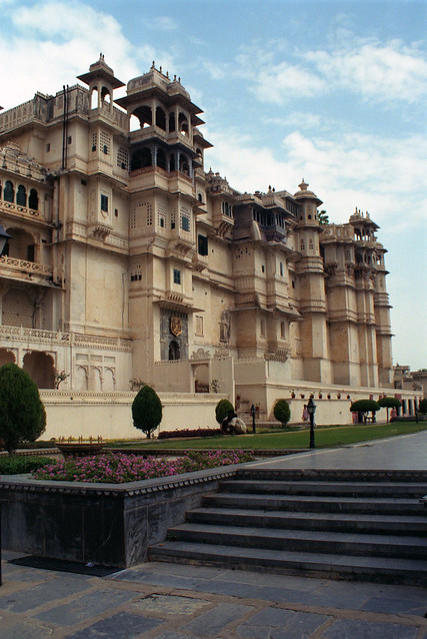
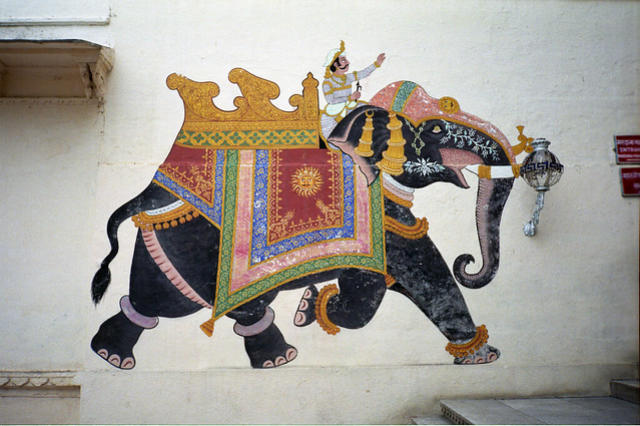
Day 7 - Wednesday 10th July.
I got up quite late, and then went with Raphael to the tiny branch of the State
Bank of India just outside the City Palace, but it was closed. After that I waited
while he went back to the miniature painting shop to pay for the painting he
had bought the day before. While we were doing all this we noticed that the
trees near to the City Palace were full of fruit bats, asleep upside down,
waiting for nightfall when they would take to the air.
The Lake Palace, Udaipur.
We wanted to take a boat trip out to yet another palace, called Jag Mandir,
which is situated in the middle of Lake Pichola. We went down to the jetty
where the boats launch from but were told to come back at two o'clock, so we
retreated to the hotel for a rest.
When we came back to the jetty we boarded a lake cruiser with many plastic
seats and an engine that proved very reluctant to start. The short trip out to
the centre of the lake was very pleasant, mainly because the boat had a large
canopy which protected us from the sun and we could enjoy good views of the
houses and temples that reached down to the lakeshore. Soon we were dropped
off at a flight of steps, overlooked by marble statues of elephants that lead up
from the waterline to the palace of Jag Mandir. The palace was built by
Maharana Karan Singh and it is said that Shah Jahan gained many ideas for the
architecture of the Taj Mahal from it when he stayed there. These days most of
the palace seemed to be neglected and run down and as far as we could tell,
only the courtyard was open to visitors. However, the courtyard alone was
worth the visit since on one side a cloister with slender marble pillars looked
back to the city, offering superb views of both the Lake and City palaces, while
on the other side of the enclosure the main part of the palace was flanked by
tall palm trees. Most of the quadrangle was taken up by a neat garden, where a
Myna bird was foraging for small insects. After we had taken some photographs,
we went back to the steps to wait for the boat to pick us up and take us back
to the City Palace. When it was slow to arrive we were worried that they had
forgotten about us and that we might end up as food for the vultures!
Jagmandir Palace, Udaipur.
Back at the hotel, Raphael and I were having a drink and resting when we met
three English girls who were sitting at the next table. Sam, George and Emma
were doing their journey in the opposite direction to ours and had started at
Delhi and gone on to Jaipur before arriving in Udaipur. They suggested that
later we could all go to a restaurant for a meal.
We met up with Mukesh again, to go and see the zoo and some traditional
Rajasthani folk dancing. The zoo was quite close to our hotel, set into a large
park, and the exhibits included four tigers, a crocodile tank and a monkey
enclosure. The tigers were kept in the most appalling conditions, their cage
was dark and awash with urine and the poor animals were either lying down in
total boredom or pacing up and down in frustration. The crocodile was not
much better off, it was condemned to live in a tank of fetid water that was fast
filling with rubbish. Thankfully we were soon on board Mukesh's friend’s
rickshaw and heading for the folk dancing theatre.
